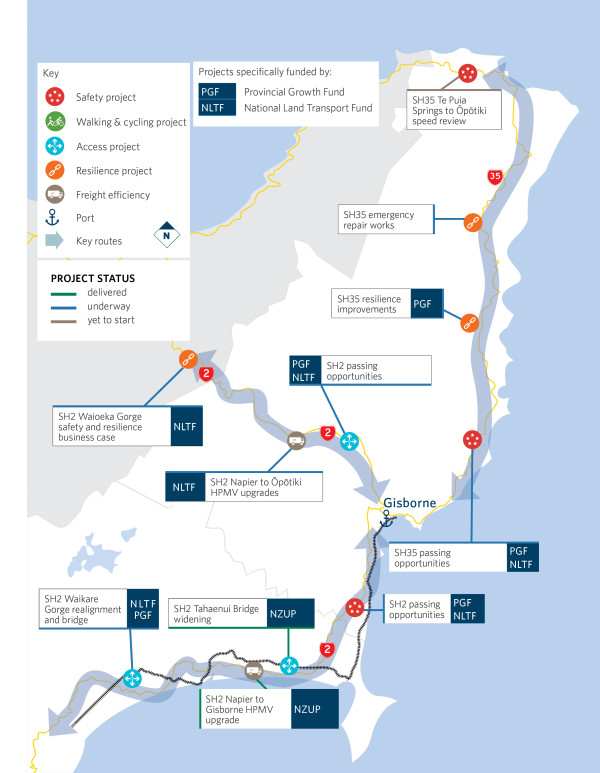For Gisborne’s economy to grow and for people to access essential health, education and employment opportunities, investment in the land transport system through the 2021–24 NLTP is supporting improved access and increasing resilience of the road network.
The region’s relative isolation means businesses and communities rely on having access to safe, reliable transport to get their goods to domestic and international markets and to access essential services. SH2 through the Waioeka Gorge is one of these critical routes. A business case is currently being completed to look at how to improve resilience at the high risk sites along this route, which is vulnerable to slips and rockfall. Work is expected to get underway on these improvements in this NLTP period.
The topography of Gisborne – a hilly, mountainous interior, low-lying river plains and coastal flats – makes the region prone to erosion and slips. It is also vulnerable to the impact of climate change and extreme weather, as seen in March 2022 weather event which has had the most significant impact on Gisborne’s state highways since Cyclone Bola, 33 years ago.
A number of resilience projects are underway or expected to start on SH35 to strengthen and stabilise hot spots along the coast, such as at Busby’s Hill and Kopuaroa. These projects include various treatments to improve resilience, such as retaining walls and rock protection to reduce erosion, retreats which involve moving the road to more stable ground, as well as native planting programmes to help stabilise slopes and roadsides.
Following last year’s speed review along SH35, which resulted in speed limit changes from Gisborne to Te Puia Springs, we have completed a review from Te Puia Springs to Tokomaru Bay township. Additional corridors within the region have also been identified for speed limit reviews to ensure the speed limits are safe for everyone who uses these roads. As part of this process, infrastructure improvements such as speed limit signage, traffic calming measures and line marking changes are also being completed.
As part of the Tairāwhiti Roading Package (TRP) announced in 2018, additional passing opportunities will be built at a cost of $33 million along SH2 and SH35. We are on track to deliver 21 sites, a mix of new slow vehicle bays, extensions to existing slow vehicle bays and mobile phone laybys. Five sites are complete, 10 sites are planned for the 2022/2023 financial year and six for the 2023/2024 financial year.
Waka Kotahi wants to achieve better road safety outcomes with Māori. We have started the Improving Road Safety with Māori project under Road to Zero Te Ara Ki te Ora. The He Pūrongo Whakahaumaru Huarahi Mō Ngā Iwi Māori | Māori Road Safety Outcomes Report has been produced to help people understand where we are starting from and the data limitations that currently exist.
The Improving Road Safety with Māori project team will work with Māori to hear more from them about the key challenges facing their people. We will do this initially in two regions, including Te Tairāwhiti, taking a listen first approach, before we partner to develop a way forward. The next steps in this journey may take time but we are committed to doing better for Māori, making sure people are getting home safe to their whānau, hapū, iwi and hapori community.
In this NLTP, we’re investing $3 million to maintain and develop Gisborne city’s public transport services, with funding for an improved ticketing system, and a strategic review of the city’s public transport system.
Through the TRP $13.5 million is being spent to improve the reliability and resilience of SH35. The work includes native revegetation, retaining structures, retreats and coastal erosion protection at 14 sites. Five of the highest-risk sites have been delivered with the remaining nine to complete by mid-2024.
We’re also investing in safety and resilience improvements through SH2 Waioeka Gorge, a key freight route for Gisborne. A business case is underway, which is expected to be completed in 2022. It will identify ways to improve the resilience and safety of this key route.
For many years, SH35 communities have requested improved wayfinding and Marae signage. Following iwi engagement, a suite of signage was created and installed at Marae located along SH35 (14) and SH2 (2). The first advises road users there are likely to be elderly and young pedestrians ahead and features an image of a kuia (elderly woman) holding the hand of a tamaiti (child). The second is a red kokowai ‘Marae’ sign that has a range of Māori motif options to identify the name of the Marae and the third is a flip-down tangi sign.
| NLTP | Investment in 2021/22 | Forecast investment for 2021-24 |
| Total | $91 million | $259 million |
| Maintenance and operations | $75 million | $199 million |
| Public transport investment | $1.2 million | $3.5 million |
| Walking and cycling | $1.4 million | $3.2 million |
| Road to Zero (safety) | $1 million | $5 million |
| Network improvements | $5.4 million | $11 million |
